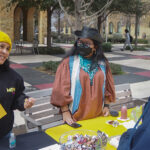On Halloween, trick-or-treaters once haunted neighborhood streets until midnight. Now they also haunt malls, college campuses, community centers and other organized spots to fill their bags with candy.
Is the tradition of trick-or-treating coming to an end, or is something else lurking in the shadows? According to a 2011 survey by Safe Kids Worldwide, 73 percent of parents still take their children door-to-door for the Halloween activity. Half of them go to school parties, and 36 percent attend community festivities at malls, recreation centers and parking lot trunk-or-treat events.
Some parents are now leaning more toward those safer events, while those who say the dangers of trick-or-treating are exaggerated continue to celebrate the door-to-door Halloween tradition.
“The news doesn’t discourage me from celebrating Halloween,” said Kassidy Hanner, a mom and interdisciplinary studies senior at Texas A&M University-San Antonio. “I feel that the things they say is a bit too much, like being overly cautious.”
Hanner has a 3-year-old daughter.
“We usually attend trunk-or-treat first for about 30 minutes,” Hanner said. “We then go trick-or-treating in my parents’ neighborhood where I grew up, so I’m comfortable there. We personally know all of the neighbors, so nothing bad normally happens there.”

According to History Professor Dolph Briscoe, trick-or-treating developed a reputation as unsafe in the ‘70s and ‘80s.
Briscoe said during that time some of the biggest serial killer cases, such as the mysterious Zodiac Killer and Ted Bundy, were unfolding. These killers would usually commit their crimes at night, causing people to avoid being out of their homes after dark.
Slasher films like “Halloween,” “Friday the 13th,” “My Bloody Valentine” and “Nightmare on Elm Street” were also growing in popularity around this time. These films created a fear of killers lurking in the night and kidnappers waiting in alleyways.
Briscoe said as time progressed and the media produced more films and television shows related to crime, parents created a curfew for their children to be home before nightfall, advising them to avoid walking alone.
“When I was a child, my mom and some of our friends always joined my brother and I for trick-or-treating,” Briscoe said. “I hardly remember ever going by ourselves.”
Though the growing fears of violence during the ‘70s and ‘80s played a role in the decrease of the trick-or-treat tradition, it is not the only factor to blame.
Lack of interest is also a big factor, begging the question: “When are kids too old to go trick-or-treating?”
According to a 2017 story in Time, most kids start losing interest in this tradition at age 12.
“As a kid, I would love Halloween and the tradition of choosing a costume and go door-to-door asking for candy,” said computer information junior Aldo Maldonado. “As I started growing up, the idea of going trick-or-treating became lame and not worth it anymore”.
As children grow up, the interest in this tradition declines Halloween costume parties and other events become more popular.
“I prefer dressing up and going out with my friends on Halloween,” said business senior Cristopher Vidrio. “Trick-or-treating was fun; now it seems like it’s a little kid’s tradition.”
Rose Gutierrez, administrative associate in the College of Business, still goes trick-or-treating with her kids. She has a 7-year-old boy and a 1-year-old daughter. She likes to take them trick-or-treating because they enjoy being outside.
Gutierrez goes trick-or-treating with her two kids and husband and they usually start around 6 p.m. and trick or treat for an hour to an hour and a half. This year, her son is going to go dressed as a pirate and her daughter is going as Tinkerbell.
Psychology sophomore Elizabeth Huerta feels more parents are worried about something happening to their child because of things such as shootings and sex trafficking. She does not plan on going trick-or-treating this year.
“I feel like there’s less trick-or-treaters now,” Huerta said.
Instead of walking door-to-door to get candy, Ariel Simpson, an alumna with a psychology degree, said she prefers trunk-or-treat events on Oct. 31.
“My daughter is still little, so it’s easier for me to take her to trunk-or-treat at the church.” Simpson said.
News about the dangers of trick-or-treating has impacted some parents into thinking negatively about the holiday.
“A lot of the news scares me, mainly because of the sewing needles some people have previously put in children’s candy,” said Simpson. “I still plan on taking my daughter trick-or-treating though. I always double check the Halloween candy to make sure it’s safe to consume.”






